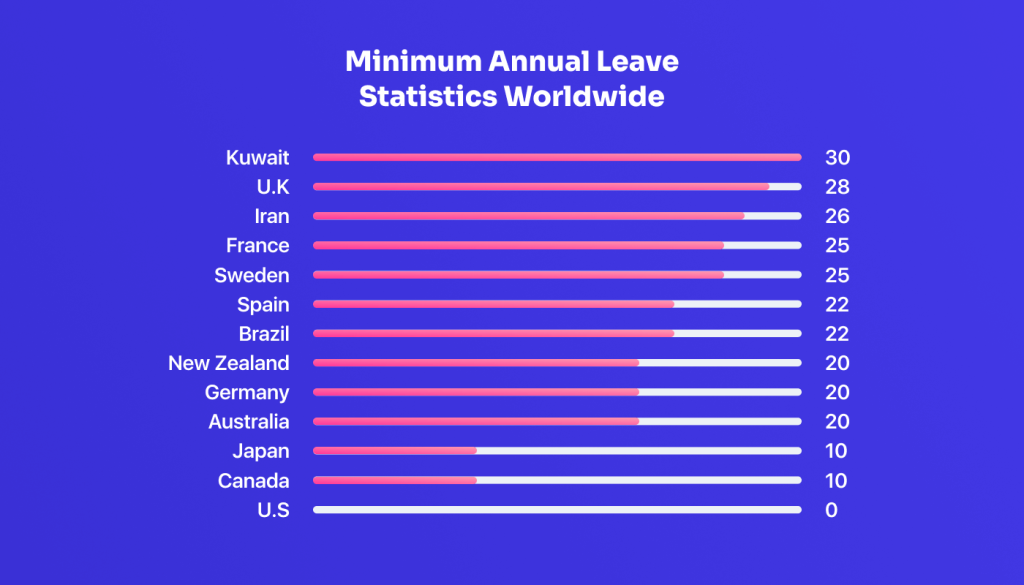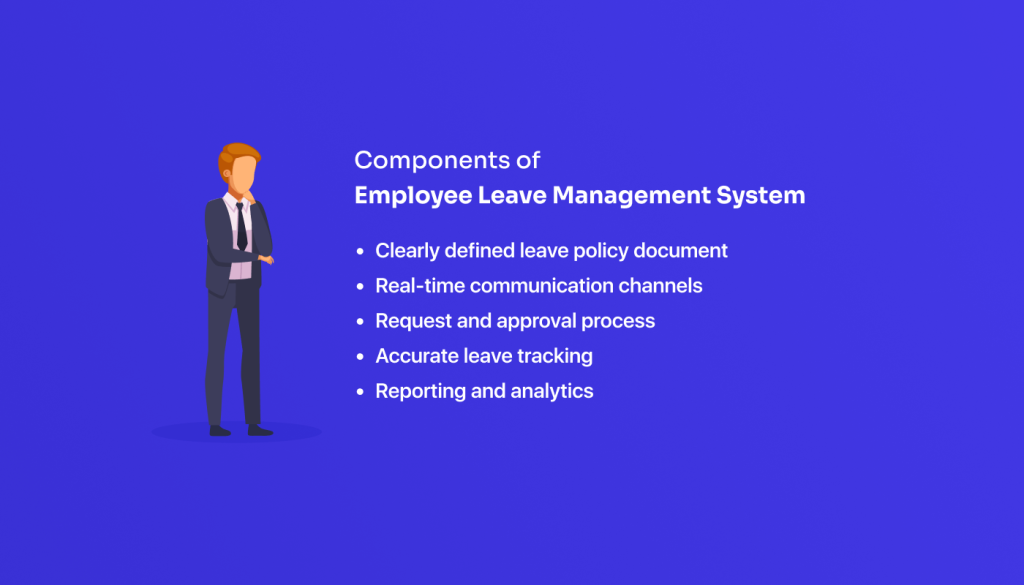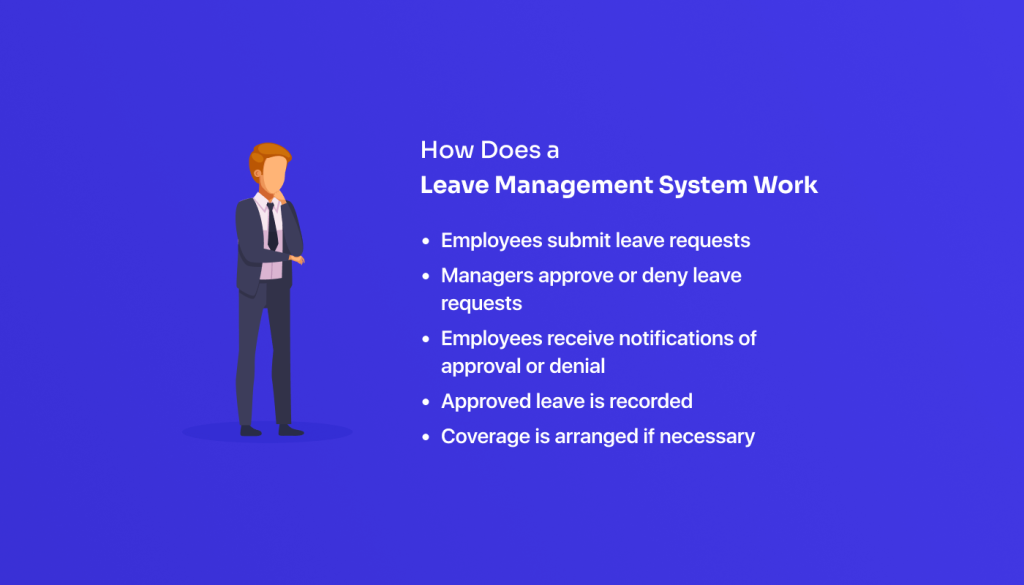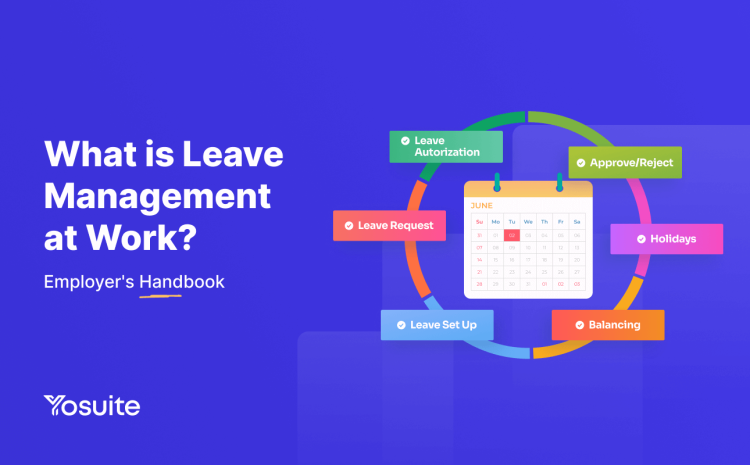A well-structured leave management system helps to create a positive work culture. Also, it ensures compliance with legal laws and regulations.
However, many employers, especially in their early days, struggle to balance employee leave management with operational requirements.
In this guide, I’ve discussed what leave management is, why it’s important to understand, and how to create fair policies that work for everyone.
What is Leave Management
Leave management is all about handling employee time off fairly and tidily. It involves creating clear policies, adjusting leaves, and approving requests for vacations, sick days, and emergencies.
Also, the leave management system tracks hours, days, or weeks of employees’ total time off depending on your company policy.
Effective leave management ensures employee well-being, compliance with laws, fair treatment, and efficient workload planning, making a productive work environment.
Types of Leave in the Workplace
Understanding the types of employees’ accrued leaves is essential to develop a clear and effective leave management system. There are 2 main categories:
Paid Leave: Employees receive their regular pay while they are on leave. These are mostly applicable after finishing the provision period.
Paid leave includes:
- Vacation Leave for relaxation, often accrued over time.
- Sick Leave due to illness or injury.
- Maternity/Paternity Leave for childbirth or adoption.
- Bereavement Leave to grieve the loss of a loved one.
- Compensatory Off is given in exchange for working overtime hours.
The number of paid annual leaves varies even from country to country. In OECD countries, Kuwait, and the UK offer the highest paid leaves (30 days and 28 days respectively). However, the United States has no federal requirement for minimum paid annual leave.
Paid vacation is commonly included in benefits packages offered by US companies. And, the regulations regarding paid time off are maintained by state laws and company policies.

Unpaid Leave: Time off taken without receiving regular pay. This can include:
- Leave Without Pay (LWOP): Employees may request unpaid leave for reasons such as personal illness, family emergencies, or educational pursuits. Approval also depends on company policy and the circumstances surrounding the request.
📢 Fun fact: Many world-known companies such as Microsoft, Netflix, Zoom, LinkedIn, Asana, Hubspot, etc offer unlimited PTO to their employees.
Components of Employee Leave Management System

Managing employee leave effectively requires a well-structured system and elements. The following key components to ensure a smooth and efficient process:
Clearly Defined Leave Policy Document
This is the foundation of your leave management system. The document should outline:
- Types of Leave: Specify all paid and unpaid leave options available to employees (vacation, sick leave, maternity/paternity leave, etc.).
- Eligibility: Define how many days and who qualifies for each type of leave, how many days before are required to submit a request, and any accrual requirements.
- Request and Approval Process: Detail how employees submit requests and how HR, managers approve or deny them (including timeframes).
- Leave Balances: Explain how leave balances are tracked and communicated to employees.
- Compliance: Ensure your policy aligns with local labor laws.
Leave management documents clearly outline all types of employee time off. For instance, “All full-time employees accrue vacation leave at a rate of 1.25 days per month, with a maximum of 15 days per year. Requests must be submitted at least 4 days in advance.”
Real-Time Communication Channels
Open communication is vital. Consider these options to implement a balanced and clear leave management system:
- HR Software/Online Portal: Employees can submit requests electronically and track their remaining leave balance on HR PTO software.
- Mobile App: Many HR solutions or leave management/PTO software offer mobile apps such as greytHR, Timetastic, etc. Consider this type of solution to develop a convenient on-the-go option for submitting requests.
- Email: Traditional email may still be a valid option for some employees.
Streamlined Request and Approval Process
A clear and efficient process saves time and reduces errors:
- Standardized Forms: Use electronic forms with clear instructions to avoid confusion.
- Automated Workflows: Set up automated routing for approvals based on the manager or HR department.
- Notifications: Keep everyone informed with automatic notifications for requests, approvals, and denials.
Accurate Leave Tracking
Accurate tracking ensures fairness and avoids payroll issues. Here’s what you should consider:
- Automated Leave Tracking System: Invest in software to automate leave accrual, deductions, and balance updates.
- Regular Reviews: Conduct periodic audits and analytics to ensure accuracy.
Reporting and Analytics
Data helps to make informed decisions. Make sure, your employee leave management system has a well-defined analytics dashboard and reporting tools:
- Leave Trends: Analyze reports to identify patterns in leave usage across departments or employee groups.
- Policy Review: Use data to assess the effectiveness of your leave policies and make adjustments if needed.
- Planning & Budgeting: Understanding leave patterns can help with staffing and budgeting for future periods.
How Does the Leave Management System Work?

A Leave Management System (LMS) simplifies the process of managing employee leave. Let’s see how it works in action:
Employees Submit Leave Requests
- Employees submit leave requests through user-friendly leave management software such as TalentHR, BambooHR, AbsenceSoft, etc, or their mobile apps.
- They’ll typically specify the type of leave (vacation, sick leave, etc.), dates requested, and any additional details.
- The system can automatically check their remaining leave balance to ensure they have enough time available.
Managers Approve or Deny Leave Requests
- After that, human resources (HR) or managers receive notifications of new leave requests.
- They can access the employee’s leave balance, calendar availability, and any team coverage needs within the system.
- HR or managers can approve or deny the request electronically based on company policies and workload considerations,
Employees Receive Notifications
- Both the employee and manager receive instant notifications regarding the approval or denial status.
- The system might also send reminders to the employee about any necessary next steps (e.g., informing colleagues about their absence).
Approved Leave is Recorded
- Once approved, the system automatically deducts the requested time from the employee’s leave balance.
- This ensures accurate tracking and avoids any discrepancies during payroll processing.
Coverage is Arranged if Necessary
- Depending on the company policy and the nature of the leave, the manager can use the system to find a temporary replacement or adjust workload distribution within the team.
- Facilitate communication and task handoff between the absent employee and their temporary replacement.
Benefits of Effective Leave Management at Work
72% of employees believe that a flexible work schedule, including time off, contributes to achieving work-life balance.
So, effective leave management is important for supporting employee well-being, productivity, and organizational stability. Also, helps to maintain a harmonious workplace and ensure legal compliance.
Effective leave management offers numerous advantages in the workplace:
✅ Employee Wellbeing: Time off allows employees to recharge, reducing stress, and burnout. Also, a flexible leave management system leads to happier and more productive workers.
✅ Compliance: Labor laws often mandate specific types of leave. So having a system ensures you’re following the rules as an employer.
✅ Transparency & Fairness: Clear policies ensure everyone gets the same treatment when requesting leave.
✅ Staffing & Workload: Knowing who will be out for specific days helps you plan and adjust workloads to maintain smooth operations.
✅ Improved Planning: Provides insights into employee leave management better with staffing and budgeting.
Challenges in the Leave Management System
Employee leave management also comes with its own set of challenges. With proper policy, an effective system, and time-to-time action, you can deal with them. Here are the key challenges with optimized solutions:
⚠️ Tracking and Balancing Employee Leaves
Keeping track of various types of leave, such as vacation, sick leave, and personal days, can be complex and time-consuming. Without a centralized system, errors and inconsistencies may occur in leave accruals.
💡 Solution: Utilize automated leave management software for accurate tracking and balance calculations.
⚠️ Ensuring Enough Staff Coverage
Managing employee absences while maintaining sufficient staffing levels also can be challenging, especially in industries with fluctuating demand or tight deadlines. As a result, organizations may struggle to fill shifts or meet project deadlines. Also, results in decreased productivity and customer dissatisfaction.
💡 Solution: Plan carefully and use workforce planning tools, cross-train employees, and consider flexible work arrangements or temporary staffing solutions.
⚠️ Ensuring Fairness and Consistency
Managing leave requests fairly and consistently of all employees can be difficult without standardized policies and procedures in place. In many cases, human resources and managers may inadvertently show favoritism or inconsistently apply leave policies. This also led to resentment and morale issues among the team.
💡 Solution: Establish clear, standardized leave policies, provide manager training, and implement transparent and AI-based HR software for leave request processes.
⚠️ Handling Unexpected Leaves
Dealing with unexpected employee absences, such as emergencies or sudden illnesses, can disrupt workflow and strain resources. Organizations struggle to cover essential tasks without contingency plans or backup staffing arrangements.
💡 Solution: Develop contingency plans, cross-train employees for essential tasks, and establish communication protocols for unexpected absences.
⚠️ Integration with HR Systems
Integrating leave management systems with existing HR software can pose challenges. This can raise compatibility issues or data synchronization problems. Also, improper integration causes inefficiencies and potential errors in payroll processing and compliance reporting.
💡 Solution: Invest in compatible HR PTO or leave management software, ensure smooth integration with existing HR systems, and regularly update software for optimal performance.
Leave Management vs Absence Management
Both Leave Management and absence management are 2 key components of workforce management. Leave Management focuses specifically on planned time off. On the other hand, absence management addresses a broader range of employee absences.
Here is a summary table to depict the major differences between leave management and absence management in the workplace.
| Feature | Leave Management | Absence Management |
|---|---|---|
| Focus | Planned absences | All absences including planned and unplanned |
| Examples | Vacation, sick leave, parental leave | Sick days, late arrivals, unauthorized absences |
| Process | Tracks employee leave requests, approvals, and accruals | Tracks all employee absences, reasons, and potential impact |
| Policies | Governs how employees request and use pre-approved leave types | Governs all types of procedures for reporting, tracking, and potential consequences |
| Compliance | Ensures adherence to regulations for specific leave types (e.g. FMLA) | Helps identify potential leave abuse |
| Benefits | Improves employee experience by streamlining leave requests and tracking | Minimizes disruption caused by absences and helps identify trends for improvement |
FAQs
What is the need for leave management?
Leave management is crucial for maintaining productivity, ensuring compliance with labor laws, and supporting employee well-being by effectively tracking and managing time off.
What are the best practices for effective leave management?
Best practices include having a clear leave policy, implementing automated leave tracking systems, fostering open communication, and providing training to managers on handling leave requests sensitively.
How can an organization improve leave management?
Organizations can improve leave management by creating clear policies and using a centralized system for requesting, tracking, and approving leave.
What is the HR’s role in employee leave management?
HR plays a central role in employee leave management by developing policies, ensuring compliance, and addressing related issues for a smooth process.
Final Words: Implement an Effective Leave Management System
Effective leave management isn’t just about ticking boxes; it’s about bringing a culture of trust and employee well-being. You create a win-win situation for both your employees and your business with a well-defined leave management system.
This will ultimately lead to a happier and more productive team. So, invest the time and resources to build a robust leave management system to empower both your employees and your organization to grow!



Leave a Reply